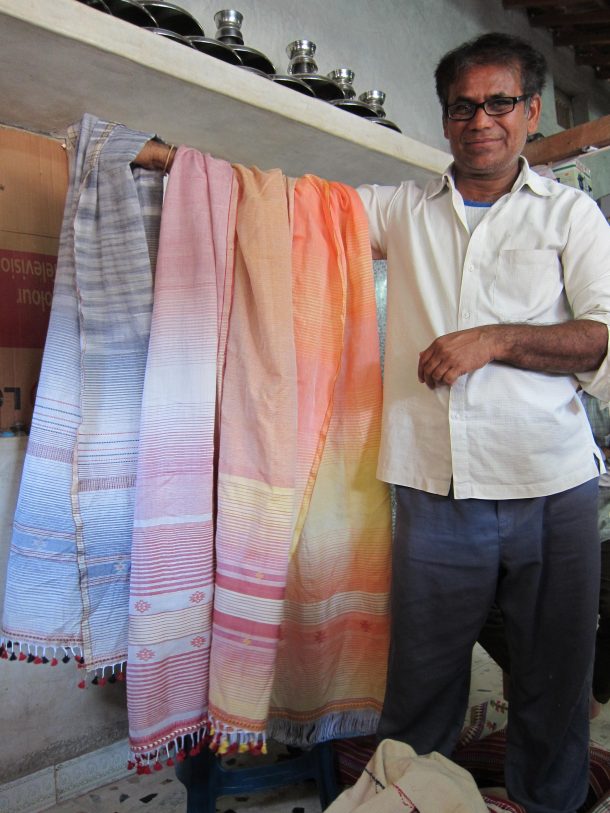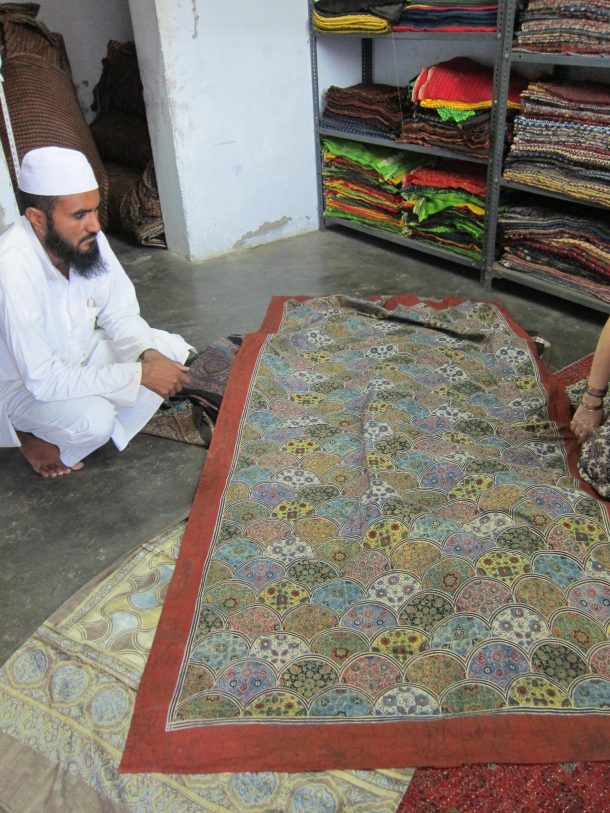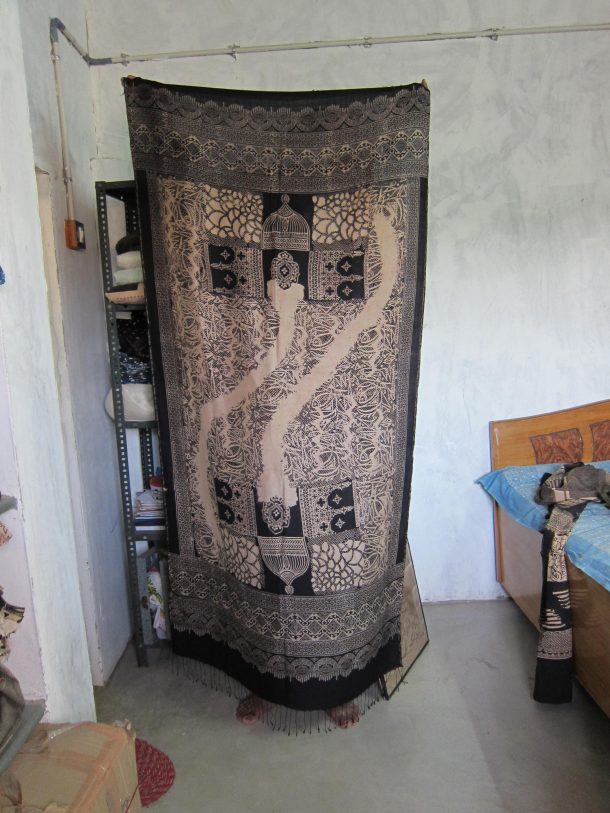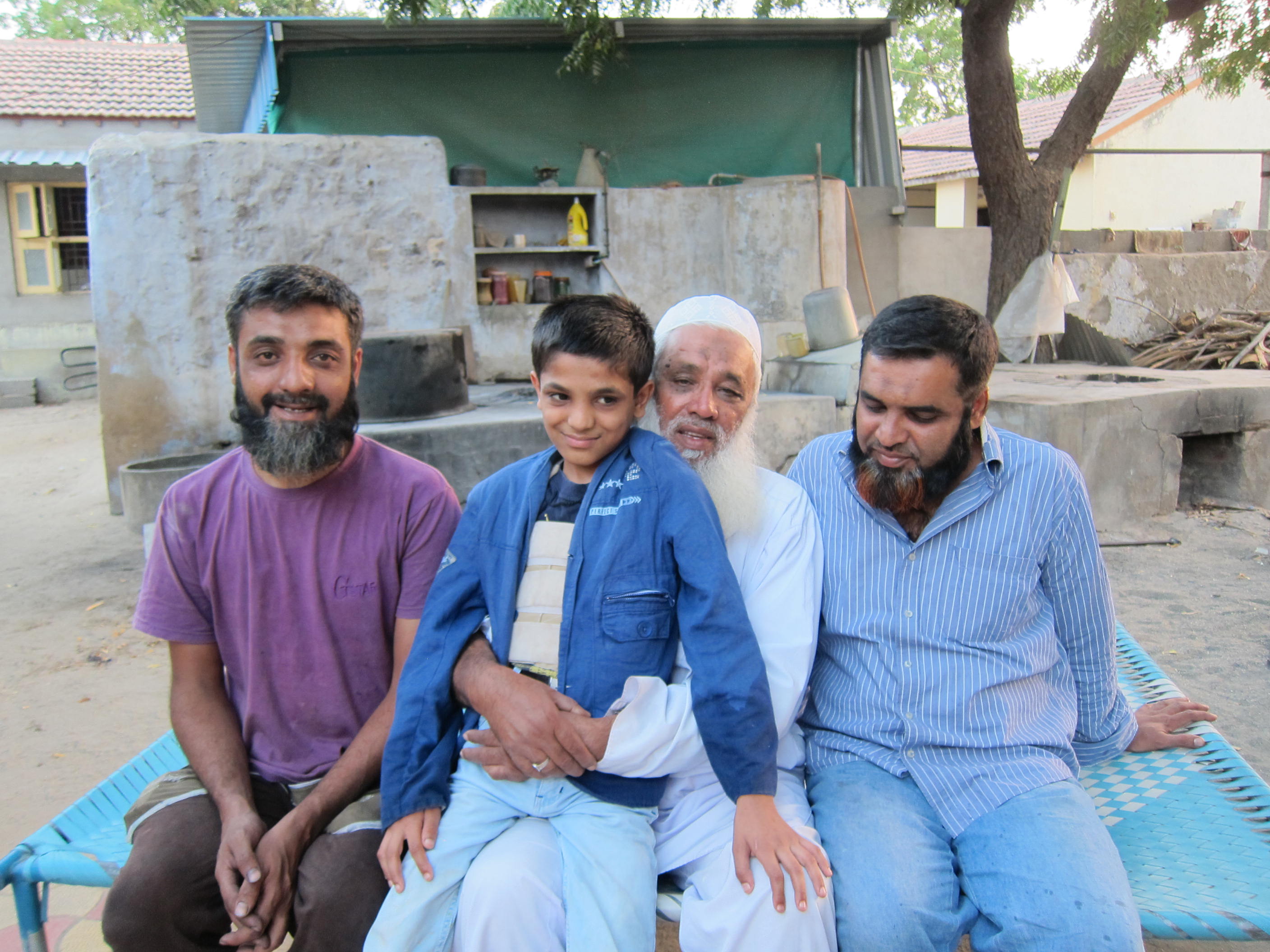I was in Bhuj last week, not because I was hiding from the police, but because I was in search of interesting textiles. Sorry – I really couldn’t help that reference to the film, In Bruges, but as you might imagine, being in Bhuj, Gujarat, is very different from being in Bruges, Belgium.

Bhuj is known for its craft production, particularly textiles, and as I journeyed through the dustry roads I was able to see all sorts of processes from sizing the warp, to indigo dyeing and weaving and I was able to talk to the artisans.
I was guided in my visit by Judy Frater, who has lived in Bhuj for much of the last thirty years. She is passionate about providing traditional artisans with an education programme that helps them design and make products that suit growing urban markets. The programme encourages artisans to take charge of their own creativity and explore their traditions in a contemporary context. As design education in colleges and universities is not accessible to these artisans, it is a unique programme which was initially taught at the Kala Raksha Vidhalaya (KRV) and is in the process of shifting to Somaiya Kala Vidya. I met with some of KRV’s graduates who now call themselves artisan-designers.
Dayalal Kudecha is a weaver living in Bhujodi who once wove heavy woollen shawls for the Rabari. He talks very enthusiastically about how the training he received from the KRV has enabled him to develop ideas and experiment with materials and colour. He now weaves cotton and silk stoles and saris that sell very well in Mumbai and Delhi. In order to keep up with the demand he is training another weaver and developing his own logo and branding. It was a pleasure to meet him as his self-confidence and positivity was very infectious.

In Ajrakpur, I met Irfan Khatri. He showed me pieces he exhibited as works of art, as well as pieces that his workshop supplied to Fabindia and other boutiques and stores. In some instances these commercial orders are for fabrics that he has designed, in others it may be fabric that has been designed by someone else and he is providing the artisanal labour to produce it. To my surprise he also pulled out fabric that had been inspired by the V&A! While showing his work in Oxford at Art in Action he visited London and the V&A and was inspired by the jalis (screens) on display in the Nehru Gallery. It is easy to see how these would be commercially successful. While his ‘art pieces’ carry his name, the commercial work will carry the brand names of other companies.


Brothers Aziz and Suleman Khatri live in Bhadli and are specialists in tie-dyeing. On the day of my visit, there were rows of beautiful woollen shawls in a striking black and white geometric design hanging out to dry in their back yard. I was told that they were made from merino wool that had been handwoven into shawls in Kashmir, then sent to Bhuj for them to create the design using clamps and discharge printing, after this they would be forwarded to Australia to the company that commissioned them who intended to sell them internationally. Aziz mentioned that although the design is adapted from one of his own and uses his incredible skill, his name will not be on the label. The brothers then showed me beautiful tie-dye pieces which displayed their innovation with this technique. They are proud to say that their town is now known as a place where innovative tie-dye is done, and people find them even though they are off the beaten track. I did acquire their work for the exhibition but I don’t want to reveal which piece until the exhibition!

Khalid Amin, also from Ajrakhpur, showed me bold abstract hangings, some of which have been hung in art galleries. He also does ‘regular’ work, stoles, shawls and cushion covers which he sells through seasonal sales in Mumbai and Delhi. I could feel a real sense of frustration from him as he wanted to create more art pieces but needed to be commissioned to do so and needed other sources of inspiration beyond Bhuj.

Dayalal, Irfan, Khalid, Aziz and Suleman all deserve recognition for their creativity and skill. Their work is split between the ‘regular’ pieces that ensures an income and the ‘art pieces’ that give them scope for their imagination. As they develop their businesses and expand they too are dependent on others who do the mundane work such as the women who tie the knots for the tie-dye, the men who block-print for the large orders. It will be interesting to see how they support the next generation of artisan-designers who may emerge from these workers.
My overriding impression from this visit was meeting some very skilled and creative artists and seeing how such beautiful textiles are made in semi-urban/semi-village settings, within family homes and basic back-yards. I am also mindful of their international reach and how people across the world may be unaware of the skilled craftsmanship from India that goes into the making of their stoles, shawls, tablecloths, curtains and duvet covers.
In the exhibition we will be showing the work of some of these artisan-designers through a section which explores the adaptation and innovation of traditional techniques. To see which pieces I acquired you’ll have to come to the exhibition.
So last week I was in Bhuj, this week I’m in Mumbai, today I was at the film institute, and so the researh continues..

Really looking forward to this exhibition. You have a great, but difficult job in summing up Indian textiles in just one exhibition as there is such a wealth of wonderful fabrics all over the country. I regularly visit Kutch and recently visited all the artisans you’ve mentioned in this post. They do fantastic and innovative work, helped in no small part by KRV. Thank you for keeping us up to date with your research and travels and the preparation for the exhibition!
Please keep me informed about all activities concerning the exhibition-thanks!
wonderful article, thankyou! am buzzing with inspiration, and excitement at the prospect of the exhibition. Heading back over to beloved India for my own research trip soon. Such amazing skills, and so good that a wider audience will be made aware of them. Is timely indeed.
Dear Ruth
Sorry for the delay in responding, the rest of my travels in India were hectic and marred with some ill health. However, I’m back in London now and eager to show everyone my acquisitions. The exhibition is a challenge but one that we are truly excited about. We hope that it will convey the rich history of Indian textiles through key themes and fabulous objects. Many thanks for writing in and I’ve had a look at your blog also – some great stories there. Hope you’ll stay with us for the journey to the exhibition opening.
Hello Sabine,
Keep checking the blogs for information and you can also follow me on twitter @DiviaPatel1 for regular updates.
Good luck with your research trip – nothing like getting out there to see the wealth of textile creativity.
It is wonderful to read your blog and hear about your travels. I lead groups to India to explore textiles and craft and am returning this November with a group to spend time with the most skilled ladies who hand embroider – Surya’s garden in Hampi – such a wonderful place with brilliant ladies. Am really exciting about The Fabric of India exhibition and please do contact me if you would like to hear more about what I do. My Facebook page is called Indian crafts study trips.
i have a very big collection og textile from sindh. i am based in jaisalmer rajasthan
if you are looking for such pieces than let me know
thanks
regards